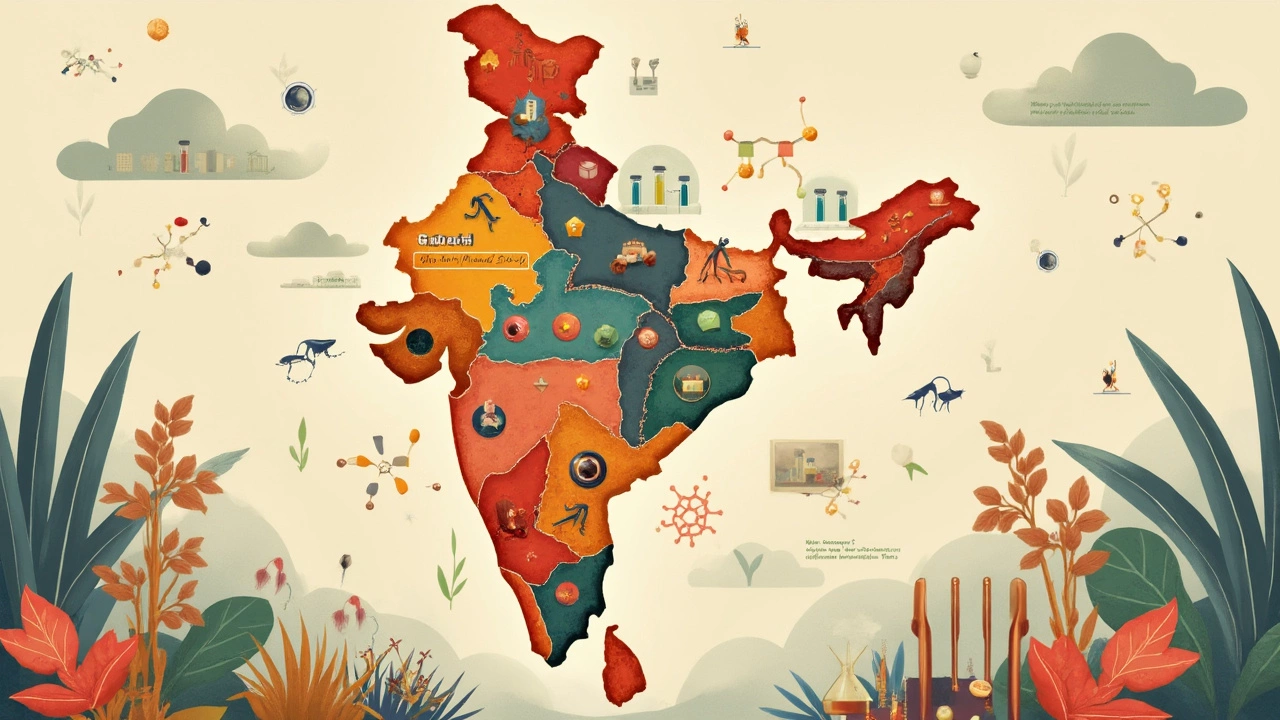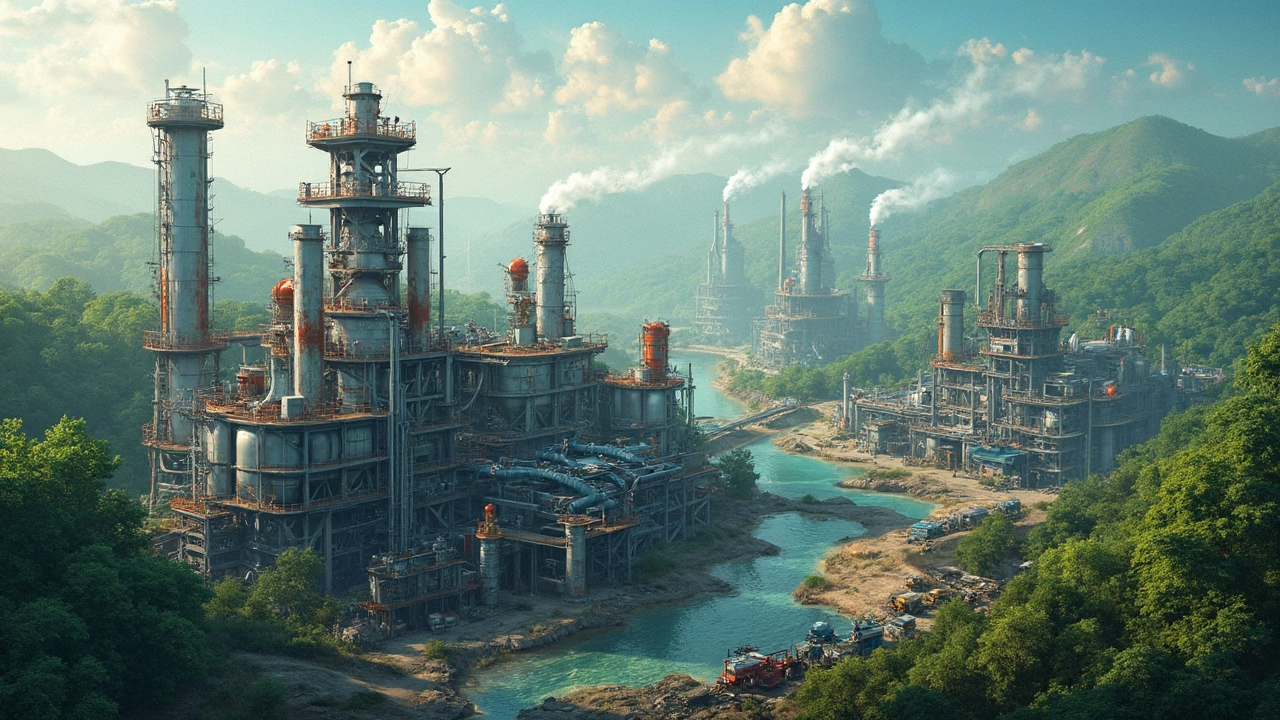Ever wonder why India is a major hub for global chemical production? Well, it’s no accident. India’s chemical industry is like that hidden engine in a high-performance car—essential but often underestimated. From bustling factories to expansive ports, the journey of a chemical in India is both fascinating and complex.
India produces an incredible variety of chemicals, playing a pivotal role across different sectors. Take industrial chemicals, for instance. These are your everyday unsung heroes, making everything from plastics to paints possible. In places like Gujarat and Maharashtra, these chemicals are manufactured at such scale, they could fill thousands of swimming pools, if anyone was crazy enough to do that!
Then, there’s fertilizers. Picture this: India’s farmers, with sprawling fields of rice and wheat, rely heavily on local fertilizers to keep the cycle of life going. Without them, your favorite dal tarka may not even exist. And let's not forget, India’s pharmaceutical industry is a global player too, delivering essential medicines worldwide. It’s wild to think, but a good chunk of those pills in your drawer might have an Indian origin story.
- Overview of India's Chemical Industry
- Industrial Chemicals and Their Applications
- Fertilizers: Backbone of Agriculture
- Pharmaceuticals: Global Demand and Production
- Environmental Challenges in Chemical Manufacturing
Overview of India's Chemical Industry
India’s chemical industry is no ordinary player in the global arena; it's a massive, dynamic force. With its roots deep in everyday applications, this industry is crucial to countless sectors, from textiles and agriculture to pharmaceuticals and dyes. It’s like the behind-the-scenes magician making everyday life possible.
In fact, India ranks among the top five producers of chemicals worldwide. It's not just about quantity but variety, as the mix includes bulk chemicals, agrochemicals, petrochemicals, and specialty chemicals. And here's a fun fact: the industry contributes to more than 7% of the country’s GDP. That’s a big chunk!
Key regions like Gujarat and Maharashtra lead the charge, hosting huge industrial clusters that drive innovation and production. These powerhouses are responsible for a large share of the country's chemical output, truly making them the beating heart of the industry.
The industry’s strength doesn't stop at domestic borders. Thanks to its diverse manufacturing base, India’s chemical manufacturers cater to global markets, exporting to over 175 countries. This international reach underscores India's role as a central hub in the global supply chain.
Got an eye on technological advancement? You’ll love knowing that Indian companies are leveraging cutting-edge technology and sustainable practices to stay competitive. However, like any mega-industry, it’s got its fair share of challenges, particularly around environmental impact and compliance with evolving international standards.
Here's a snapshot of some significant contributions and exports within the industry:
| Category | Contribution/Export (in Billion USD) |
|---|---|
| Petrochemicals | 18 |
| Agrochemicals | 6 |
| Specialty Chemicals | 12 |
With strong governmental support and rising demand, the future looks promising. It’s no wonder India’s gearing up to become a more significant player in chemical production on the global stage. Those in the industry or looking to dive in should keep an eye on these trends and developments.
Industrial Chemicals and Their Applications
When looking at chemical manufacturers in India, industrial chemicals take center stage. These substances are produced in mind-boggling quantities and keep the wheels of numerous industries turning, from construction to textiles.
Let's talk about basics first. Ever thought about where your daily use products come from? Well, industrial chemicals like sulfuric acid, caustic soda, and ethylene act as the backbone for a lot of things you interact with daily. Whether it's your disinfectant or the plastic bottle you drink from, these chemicals play a key role.
Gujarat is a superstar in the industrial chemical scene. This state alone hosts numerous manufacturing plants churning out tons of materials that end up worldwide. The chemicals produced here support industries such as textiles, detergents, and plastics. Imagine this: without these chemicals, the manufacturing sector would slow down, affecting a multitude of products you use daily.
- Sulfuric Acid: Used in making phosphoric acid, essential for fertilizers.
- Caustic Soda: Key in soap and detergent production.
- Ethylene: Fundamental for making plastics and synthetic fibers.
There's a good reason why India's chemical industry is still growing. Industries worldwide are always in need of these chemicals for their products, keeping the demand high and the factories busy.
Yet, India faces some challenges. Logistics is one, with the vast distances between raw material sources and factories sometimes causing bumps in the road. Despite this, India's status as a chemical hub continues to shine brightly in the global market.
Here's a quick look at some significant industries benefiting from Indian industrial chemicals:
| Industry | Major Chemicals Used | Application |
|---|---|---|
| Textiles | Aniline, Sulfuric Acid | Fiber and dye production |
| Detergents | Caustic Soda, Sulfur | Cleaning products |
| Plastics | Ethylene, Propylene | Packaging, containers |
Understanding these applications gives you a real sense of how interconnected these industries actually are. It also highlights the vital role India plays in keeping countless global industries afloat. Pretty cool, right?

Fertilizers: Backbone of Agriculture
In the vast, vibrant world of Indian agriculture, fertilizers are the unsung heroes making it all happen. With a population to feed that's over a billion strong, India's fields are a crucial player in the global food supply chain. But how do these fields stay so productive? You guessed it—fertilizers are a big part of the magic sauce.
For starters, India’s climate varies wildly— from the sizzling heat of Rajasthan to the lush greenery in Kerala. This diverse landscape requires fertilizers tailored to different crops and conditions. The country is among the top producers of urea, nitrogen, phosphorus, and potassium fertilizers, collectively known as NPK fertilizers. These are the workhorses keeping the soil nutrient-rich, and crops healthy.
“The application of fertilizers has revolutionized agriculture in India, tripling cereals' productivity within the last few decades,” says Dr. R.K. Choudhary, a respected agronomist.
But India’s fertilizer industry isn't just about big factories churning out products. It's a carefully balanced dance between government policies and the agricultural sector. The Indian government provides subsidies to ensure that fertilizers remain affordable for farmers. This way, even the smallest family-run farms can boost their yield without breaking the bank.
| Fertilizer Type | Percentage of Total Production |
|---|---|
| Urea | 55% |
| Phosphorus | 23% |
| Potassium | 12% |
| Others | 10% |
It’s not just about quantity, though. Quality matters a ton. Companies in Maharashtra and Gujarat meticulously monitor the chemical composition of fertilizers to meet international standards, ensuring they provide maximum benefits while minimizing environmental impacts. This attention to quality is why India stands as a significant player in the chemical manufacturing industry.
However, the journey of fertilizers in India isn't without bumps. Issues like distribution challenges and environmental concerns keep industry leaders on their toes. There’s a growing movement towards sustainable practices and organic fertilizers to address ecological worries. Innovations in these areas could shape the next big leap for India’s agricultural sector, making it smarter and more eco-friendly.
Pharmaceuticals: Global Demand and Production
India is often called the "pharmacy of the world," and for good reason. It churns out a vast array of generic medications at prices that don’t break the bank. This makes Indian pharmaceuticals a lifeline for many countries, especially those where healthcare budgets are tight. Ever popped a paracetamol? There's a high chance it came from India.
The country's pharmaceutical sector ranks third worldwide in terms of volume. With over 20,000 manufacturers, you can bet there’s always something in production. In fact, India supplies over 50% of generic drugs globally. That’s mind-boggling, right? Even the active pharmaceutical ingredients (APIs) that power these medicines are largely produced here, cementing India’s role as a key player.
While Hyderabad and Bangalore are known for their tech hubs, they're also beehives of pharmaceutical activity. These cities house major companies that meet the global demand for essential medicines. The sector is dynamic, heavily investing in new R&D to tackle tough diseases. This drive for innovation only makes the industry stronger, addressing the ever-increasing global demand for new therapeutic solutions.
Always driven by big needs, like during the COVID-19 pandemic, Indian manufacturers rapidly increased the production of vaccines and critical care drugs. This flexibility is a testament to their capability. Not only does it help in emergencies, but it also ensures a steady supply for ongoing healthcare challenges.
But India’s role isn't just about manufacturing bulk meds. The country is a rising star in biosimilars, crafting alternatives for complex biologic drugs. It's like India isn't just providing the building blocks but also constructing entire towers of treatment options.
Want some stats? Here’s a quick view of how influential India is:
| Category | Global Share |
|---|---|
| Generic Medicines | Approximately 50% |
| Vaccines | About 60% |
| Pharmaceutical Exports | Ranked 11th worldwide |
In conclusion, with vast production capabilities and continuous innovation, India firmly positions itself as a cornerstone of the global pharmaceutical industry. When you think of chemicals manufactured in India, remember that it's a whole universe of life-saving drugs that plays a crucial role in healthcare across the globe.

Environmental Challenges in Chemical Manufacturing
India's role as a giant in chemical manufacturers brings with it a host of environmental challenges. The production of chemicals, whether it's industrial giants or pharmaceuticals, doesn't come without its fair share of hurdles. Pollution and waste management are at the forefront of these issues.
Take water pollution, for instance. Many factories release untreated wastewater into rivers, impacting both the local ecosystem and community health. According to the Central Pollution Control Board, waterways near chemical manufacturing hubs often exceed pollution standards.
"Efficient waste management isn't just a regulatory requirement; it's an ethical imperative," says Dr. Meera Singh, an environmental scientist, emphasizing the need for industries to adopt more sustainable practices.
Air quality is another major concern. The release of harmful gases like sulfur dioxide and nitrogen oxides during some manufacturing processes contributes to air pollution and acid rain. The catch? It's challenging and costly to reduce emissions significantly.
Efforts are being made, though. Some companies have started adopting cleaner technologies, aiming for zero liquid discharge and using scrubbers to reduce air pollutants. Adoption of green chemistry principles is gaining traction too, reducing harmful byproducts.
Here's a snapshot of what's being done and what needs more attention:
- Implementation of stricter effluent treatment norms.
- Investing in state-of-the-art pollution control equipment.
- Incentives for companies adopting eco-friendly practices.
- Increased transparency and stricter enforcement of environmental regulations.
These steps can help manage the environmental impact but demand commitment and continuous effort from both industry leaders and policymakers.
